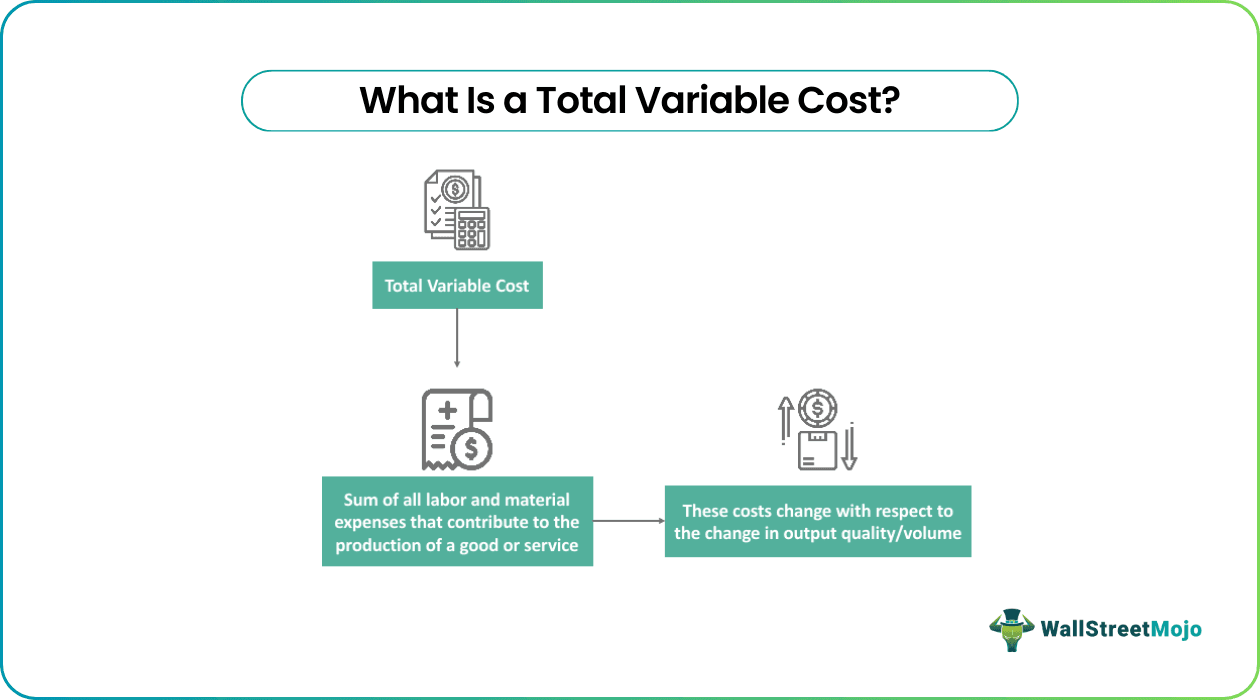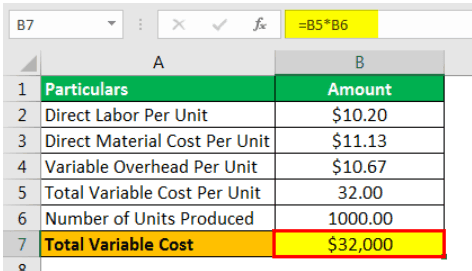Table Of Contents
What Is Total Variable Cost?
Total Variable Cost is defined as the total of all the variable costs that would change in proportion to the output or the production of units and therefore helps in analyzing the overall costing and profitability of the company.

Total variable cost is calculated by multiplying the number of units produced by the variable cost per unit. Computing this cost helps firms identify the increase or decrease in the expenses related to the production process, thereby helping them prepare accordingly for the next set of production as well as for the further increased or decreased quantity of goods that it aims to produce.
Total Variable Cost Explained
Total Variable Cost is the cost that is directly connected with the production of any item. It is called so as such costs change as and when there is a change in the volume or quantity of outputs to be produced. This means, if the number of products to be manufactured or produced increases, it leads to the increase in these costs and if the same decreases, the variable cost also diminishes.
So, total variable cost does not necessarily signifies an increase, but a decrease as well. Mostly, these costs include the labor cost, cost of raw materials, packaging cost, transportation costs, utility bills, or any expense that increase when the volume of produce increases.
Total variable costs help in determining the break-even point of a firm so that they could easily assess the number of products or quantity of products it requires to sell to cover the total costs incurred, be it variable expense or fixed expense. In case of investors, this total variable cost helps them predict the returns on their investments depending on their assumption of the capability of the firms in bearing the costs they have incurred on producing the output.
Formula
The mathematical total variable cost equation that helps calculate this figure is mentioned as follows:
Total Variable Cost Formula = Number of Units Produced x Variable Cost Per Unit

Where,
- Variable cost per unit shall include Direct Labor cost, Direct Raw material cost, variable overhead cost, etc.
How To Calculate?
To know how to get or compute total variable cost using formula, there is a series of steps that one must follow. Let us have a look at them:
- Identify the labor hours required per unit.
- Identify the material that is associated with the product and compute its per-unit cost of it.
- We must also identify other variable overheads and consider their cost per unit.
- Add all of the above per unit cost, the total variable cost per unit.
- Take out the number of units actually produced and not just sold.
- Now multiply the number of units produced by variable cost per unit.
Examples
Let us have a look at the instances below to understand the total variable cost definition and calculation better:
Example #1
A manufacturing unit that produces X as a product has the following variable cost per unit.
- Direct Labor - $10.20
- Direct Material - $11.13
- Variable Overheads - $10.67
The total number of units produced was 1,000 units. You are to calculate the total variable cost of product X.
Solution
Here we are given all the variable costs per unit, and therefore we can use the below formula to calculate the total variable cost per unit.
- Direct Labor Per Unit: $10.20
- Direct Material Cost Per Unit: $11.13
- Variable Overhead Per Unit: $10.67
Therefore, the calculation will be as follows

= 1,000 x ( 10.20 + 11.13 + 10.67 )
= 1,000 x 32.00

Example #2
HUL produces many different types of products and is a large company. It is one of the largest FMCG companies in India. Recently it was hit by the competition in the market. Now it is considering repricing products to survive the competition. It first wants to compute the total cost of production of its three major products, which include Lux, Clinic Plus, and Fair and lovely. Below is the statement extracted from its latest stock statement, submitted to the bank.
| Particulars | Lux | Clinic Plus | Fair & Lovely |
|---|---|---|---|
| No of Units Sold | 100000.00 | 80000.00 | 200000.00 |
| Closing Inventory | 10000.00 | 2000.00 | 22000.00 |
| Fixed Cost for Entire | 1500000.00 | 1500000.00 | 1500000.00 |
| Direct Labor Cost Per Unit | 5.00 | 10.00 | 12.00 |
| Direct Material Cost Per Unit | 3.00 | 4.00 | 5.50 |
| Selling Price Per Unit | 35.00 | 72.00 | 110.00 |
Based on the above information, you are required to calculate the total variable cost and total cost of production. You can assume that there was no opening inventory.
Solution
Here, the company produces three products: Lux, Clinic Plus, and Fair & lovely. To come up with a total cost of production, we need first to compute the total variable cost per product and then sum up those with a total fixed cost, which shall give us a total cost of production.
LUX
Calculation of Total numbers of goods produced

=100000+10000
- Total numbers of goods produced = 110000
Therefore, the calculation will be as follows

= 110,000 x 8.00

CLINIC PLUS
Calculation of Total numbers of goods produced

=80000.00+2000.00
- Total numbers of goods produced = 82000.00
Therefore, the calculation of total variable cost will be as follows


= 82,000 x 14 = 11,48,000
FAIR & LOVELY
Calculation of Total numbers of goods produced

=200000.00+22000.00
- Total numbers of goods produced = 222000.00
Therefore, the calculation of total variable cost will be as follows.

=222000.00*17.50


Therefore, the total variable cost in producing all the three products will be 880,000 + 11,48,000 + 38,85,000 which is equal to 59,13,000.
Total Cost

Further we are given that total fixed cost is 15,00,000 and therefore the total cost will be 59,13,000 + 15,00,000 which is 74,13,000.
Example #3
Mr. Bean sells hotdogs in the street in his vehicle. He is interested to know what the cost is that is rising with the number of hotdogs that he sells. He notices that the cost of bread increases whenever there is a demand for hotdogs, and he noted that per piece, he has to pay $1. Further, he notices that the cost of a vehicle is fixed, which is not changing and is $40,000. On average, he requires sauce, butter, and other stuff, which costs him around $5 per piece. The vegetable cost, on average, is $8 per piece. He wants to make a 25% profit on the selling price. If he produces 100 hotdogs, you are required to compute the total variable cost and the selling price that he should keep covering the variable cost, and for the time being, he avoids fixed cost calculation.
Solution
In this example, the variable cost per piece is the cost of bread, which is $1, then material cost, which is $5, and vegetable cost, which is $8 per piece, and hence the total variable cost per unit is $14 per piece.
- Bread Cost Per Unit: $1
- Material Cost Per Unit: $5
- Vegetables Per Unit: $8
- Total Variable Cost Per Unit: $14
Therefore, the calculation will be as follows

= 14*100

The selling price will be -

- = $14 / (1-25%)
- Selling Price = $18.67
Now, if it considers covering all the variable costs and wants to earn a 25% profit on selling price, it wants to earn 33.33% on cost.
Therefore, the selling price would be $18.67.
Relevance and Uses
These are the costs that shall change depending upon the output. Variable costs shall increase as the output increases and decrease as the output decreases. These costs help determine the total production cost, an individual contribution from a given product, etc. We cannot control these costs as these remain fixed and will only incur when there is goods production.
Total Variable Cost vs Total Fixed Cost
When comes to the costs associated with the production of goods and products, there are two types of expenses that a firm incurs – total variable and total fixed costs.
These differ in many aspects, which have been listed below:
- Total variable costs is the sum of all variable costs associated with the production process. A variable cost is any cost that changes with the changes in the production requirement. On the contrary, total fixed costs include the costs that remain the same irrespective of the change in the output volume or quantity.
- Let us understand the former with an example. If one wants bakes 10 cakes a day, the number of people required to bake them is less than the people required to bake 100 cakes a day. More number of people, in turn, leads to increased labor cost, thereby changing the cost incurred by a firm significantly in the latter case. On the other hand, the place required to bake those cakes still involves the same rent to be paid by the firm. In this example, the first instance require more labor for baking more number of cakes identiies the variable costs, while the second instance indicates fixed cost - the rent of the space, which remains unchanged.


